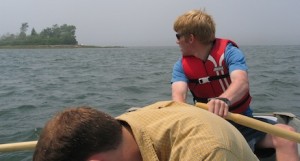 On the surface, it looks like a regular fishing trip. Gear up, haul the skiff down to shore. Row out, bait and cast your lines. Then wait for a nibble.
On the surface, it looks like a regular fishing trip. Gear up, haul the skiff down to shore. Row out, bait and cast your lines. Then wait for a nibble.
If you are Jon Allen, however, there is a catch to this story. Perhaps catch is a bad word. Allen doesn’t actually want to catch anything at all. He just wants to know who’s nibbling.
Allen is a marine researcher at Bowdoin College’s Coastal Studies Center (CSC) who is studying predation on larval marine invertebrates such as sea urchins, crabs, mussels and lobsters. He is conducting several experiments over the summer to try to determine who is eating these larvae and where they are most likely to be eaten.
“A bad day of fishing is a good day of work for us,” he jokes, threading small, translucent bait pellets onto hooks. “We are measuring our bait losses.”
During the course of one of these non-fishing trips, Allen, and his summer research assistant Eric Robinson, measure how often their bait is nibbled – or eaten outright – at various locales. They can even examine bite marks or try to catch a predator in the act by using an underwater infrared camera that transmits video to a camcorder aboard the skiff.
Eric Robinson ’07, left, lowers an infrared camera into the sea while Jon Allen prepares a camcorder for viewing the marine life below.

Eric Robinson, left, lowers an infrared camera into the sea while Jon Allen prepares a camcorder for viewing the marine life below.
“We sit on a boat, power the underwater camera, and watch what’s going on 30 feet down,” marvels Allen. (See sidebar for audio podcast recorded during a survey trip.) “We look for predators like green crabs, rock crabs, lobsters, and even bigger predators, such as fish. We have a pretty good idea of where they’ll get eaten. What we hope to get is a more quantitative measure of who is eating them.”
Allen’s is the study of the underdog, those he calls the “small, defenseless creatures that are born into the big sea.” Of these, many marine invertebrates are released onto the benthos, or ocean floor, at birth. These bottom-born often have protections, such as egg capsules or chemical defenses. They’ll need it. The benthos is believed to be the deadliest part of the marine environment; it is where crustaceans and many other predators roam.
But there are other zones to the water column, and curiously little is understood about the unprotected larvae that are released, and struggle to survive, at varying depths between ocean surface and floor.
“Predators may be less abundant in the water column, but they are just as deadly,” notes Allen. “Not only do you have a wide array of fish, you have other creatures such as jellyfish, whose tentacles serve as drag nets.”
Thus far, their collected data confirm the treacherousness of the bottom. The next step is to determine which areas of the water column are safer than others, and if predation levels shift with factors such as tides, currents, and light. Already, says Allen, they have determined that parts of the water column appear more dangerous than others.
“When you are roughly one meter off the bottom, predation is low,” he says. “As you continue up to the surface it gets high again. The peak is, of course, on the bottom, but you get a second peak at about three to six meters above the bottom.
“We also are seeing that in the course of a day, larvae make vertical migrations up and down the column. It’s not well understood why and we’re hoping to learn more.”
Ultimately Allen’s research will add important ecological information about the marine food web. And because some of the species he is studying are commercially important in Maine and elsewhere, there is keen interest in understanding the environmental threats and evolutionary strategies of these tiny life forms.
Listen to a podcast of Jon Allen describing the sea life below, as he trolls the waters offshore from the CSC, aided with an underwater camera.
Story originally posted July 31, 2006, Bowdoin College Web site.